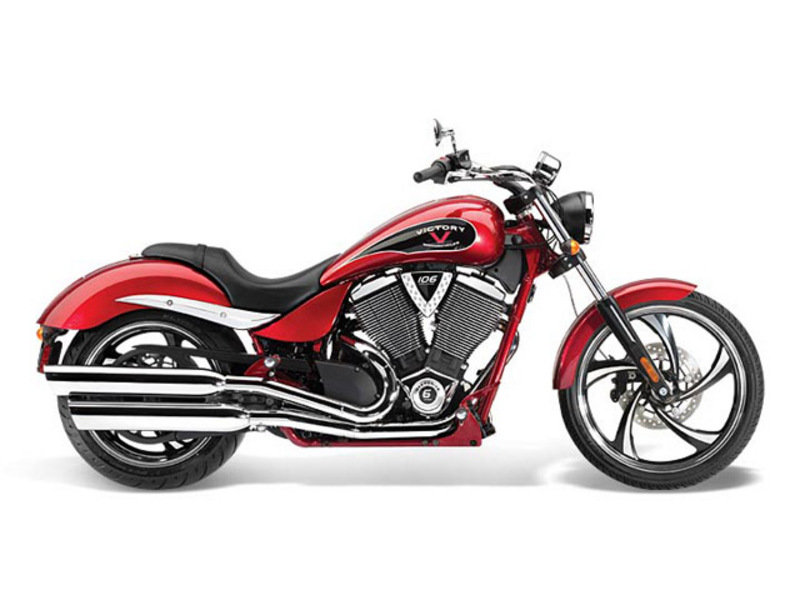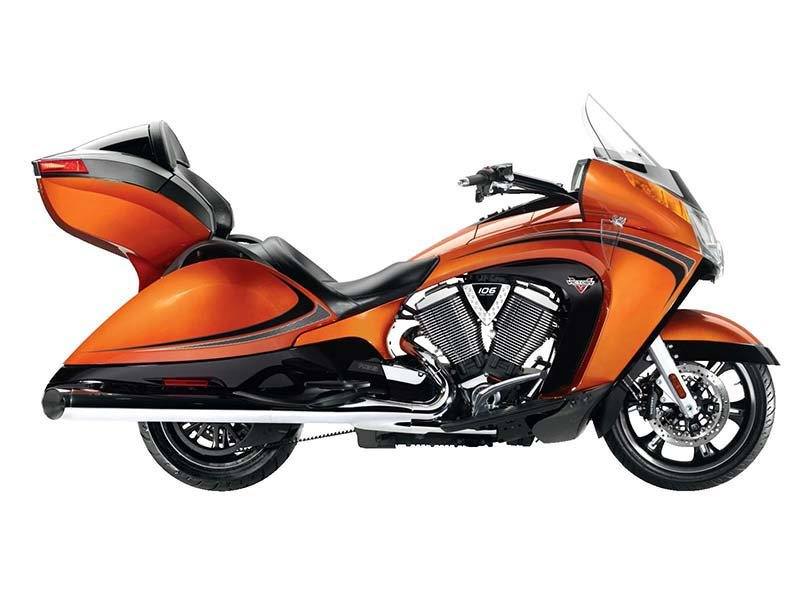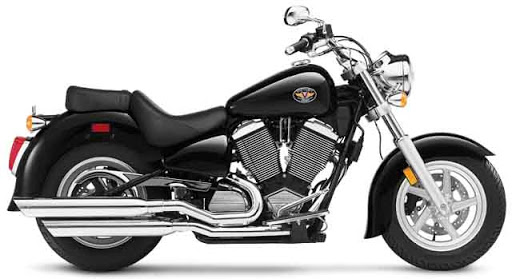Motorcycle Investor mag

Twin Peaks
Future collectibles series: Victory motorcycles
It came, it made promising noises and it went again. Is there something worth rescuing from the Victory catalogue?
(by Guy Allen - Motorcycle Trader mag #340, Oct 2018)
Back in the mid-1990s, Harley-Davidson was really the
only big game in town when it came to building motorcycles
in America. Buell, a minnow by comparison, was next in
size and doing fairly well at the time, but in a very
different market niche. As for the rest, they were tiny
outfits that weren’t about to frighten the mighty
Milwaukee giant, which at the time was surfing a wave of
expansion and success.
Then came Polaris, one of the few companies with the USA
base, the cash and the engineering expertise to have a
serious go at cracking the lucrative American cruiser
market. Better known for its powersports and light
industrial machinery (ATVs, snowmobiles and the like), the
company had modest ambitions. It was launching just one
model for the first year (see sidebar), in two colour
schemes. There would be ‘just’ 200 dealers nationwide,
though one day that might grow to 500-600.
In reality, the company enjoyed solid progress, with its
motorcycle division showing a modest profit after several
years. All that was largely academic to Australian
audiences, which didn’t get to see the machines here until
2008, a full decade after the brand launched.
When the marque was finally unveiled here – at that
year’s Ulysses Club AGM in Townsville - it was a rounded
brand offering a range of cruiser variants including power
cruisers, high-riders, baggers, tourers and the like.
That’s all fine and dandy, but were they any good? The
short answer is yes. Victory frequently outgunned the
mighty H-D when it came to performance and handling for
motorcycles in the same class. While punters had every
reason to wonder if the machine they were buying would
have halfway decent resale value, they could rest easy in
the knowledge that the engineering was excellent. Plus,
the initial purchase price was often very competitive.
For some, buying a Victory was their own little protest
vote. The sheer popularity of Harley meant there would
always be a section of the market who wanted something –
almost anything – other than the world’s most popular
cruiser brand, and Victory scratched that itch while still
having the American background.
Over the years, the company built some truly stunning
models and I’m not sure they were always given due credit.
For me, the three stand-outs were the Hammer S power
cruiser, the Jackpot ‘factory custom’ (always loved the
inherent oxymoron in that term), and the completely
out-there Vision full tourer. In all three cases, we’re
talking of the 106 cubic inch (1731cc) generation, from
circa 2010.
Even now, the Hammer S qualifies as a powerhouse when it
comes to V-twin cruisers – particularly when you’re
talking of an air/oil-cooled powerplant. The first gen
(2005-on) 1600 claimed 85 horses, while the second-gen
1740 (2010-on) packed a whopping 97 horses. That’s a big
number for an air-oil-cooled V-twin and was enough to give
the model some serious off-the-line grunt.

Several colour schemes were done over time and my
personal pick is the second-gen blue with white stripe
that mimicked Ford Cobra livery. In any case, these things
were lookers, running minimal chrome, twin discs, USD
front fork and massive 250-section rear tyre.
As with all the 1740-generation bikes, the performance
was stellar with an unsurprising emphasis on midrange
delivery. Meanwhile the six-speed transmissions were sweet
and, in the case of the Hammer, top gear was really for
highway use only.
Handling on this chassis prioritised straight line drags.
Running a substantial 140mm trail and a reasonably
conservative 32.7 degrees of rake, it required a little
nudge on the handlebars to get it turning. You tended to
also get some bump steer from that giant rear tyre, though
overall it was a stable enough package.
That’s kind of underselling the machine, however. What it
offers is the true V-twin muscle bike experience, in a
well-sorted package, for not a whole lot of money.
Mid-teens will pick up a good example, which is a lot of
motorcycle for the money.
As much as the contradictory term ‘factory custom’ makes me squirm, it has been accepted over the years as a shorthand for any cruiser model that has been dressed up to within an inch of its life to make a visual splash. And the Victory Jackpot (or Vegas Jackpot as an alternative), particularly the 2013-on versions, qualify on that score.

Produced in a lairy orange or marginally more subtle red,
the stand-out feature is the colour-matched frame. We’re
talking lots of chrome, wild-looking wheels, skinny
90-section front tyre contrasting with the 250 rear and a
l-o-n-g wheelbase. At 1706mm, it was 36mm longer than a
Hammer.
In keeping with the custom look, you got conventional
front forks, a single front disc and a slightly smaller
fuel tank.
Like the Hammer, it had plenty of straight line urge, but
was less capable as a handling package – unsurprising,
given the spec. Still, that was the price of fashion and
it was still an enjoyable enough thing to take out for a
day ride. What it lost in handling ability, it made up for
with huge visual appeal.
Prices are around the $15-17k mark. If you want something
ultra-special, there was a limited Corey Ness (son of
legendary stylist Arlen) edition, which will set you back
considerably more at low to mid-twenties.
Since we’ve raised the Ness family name, it was for a
time widely influential with Victory’s styling and no more
so than with the gobsmacking Vision tourer. It was a
courageous move to put this shape into production, as it
was instantly polarising – people tended to love or hate
it. I was one of its fans, figuring it was refreshing to
see someone try something bold in this class.

Underneath the dramatic panels, it was running the usual
106 engine, in 92-horse (68kW) form with a slight retune
for a low-midrange focus. The six-speed transmission was
topped by a proper overdrive, which enabled very relaxed
cruising revs.
Initially with optional ABS and an optional power
windscreen kit, it wasn’t necessarily the most technically
advanced motorcycle on the planet, but it certainly
stacked up as a package.
It was comfortable, with good legroom and a reasonably
plush ride. It also steered very acceptably for a
motorcycle in this class and gave every indication of
being able to show a full-house Electra Glide a clean set
of heels.
Over time, it picked up much of the techno gear it
initially missed. By 2013-14 it had ABS standard on the
linked brakes, cruise control, standard electric screen,
plus heated grips and seats. Though a seriously large
piece of motorcycle, and weighing near enough to 400kg
ready to roll, it remained an easy enough package to
handle.
The Vision sold in tiny numbers, so used examples are
thin on the ground. You can expect to pay anywhere from
mid-teens for a first-gen to early twenties on a later
model. This is one of those motorcycles that I strongly
suspect would be a very satisfying thing to own – visually
a little out there, and very good at its job.
So what’s the future for Victory motorcycles as
collectibles? It’s unlikely they’ll ever develop the
reputation of legendary redundant marques such as HRD
Vincent. However they ended up being a substantial part of
American motorcycle history and there were unquestionably
some engineering successes in the mix.
You wouldn’t plan your retirement around one of these things, but they represent decent value in the market and will always have interest as a talking point. And, they’re a pretty decent ride…
For
Well-engineered
Good performance
Against
Production ceased
****

The first Victory
As with any brand, the first in a series will most likely
eventually have collectable status, and in this case that
would be the V92C, launched in 1997 for the 1998 model
year.
The 1507cc engine was fairly advanced for an American
V-twin, boasting single overhead cam (no pushrods!),
four-valve heads and fuel injection, with somewhere in the
vicinity of 75 horses – or enough to give Harley-Davidson
a serious fright.
Its launch was attended by legendary Indianapolis racer Al
Unser junior and the bike, on paper at least, was well and
truly competitive with the Milwaukee product it was trying
to steal market share from. However, sales were relatively
modest for what was to many people an unknown quantity.
Road tests of the era were generally positive, with some
criticism of the looks of the engine. Overall, the styling
needed a little refinement.
Priced at US$13,000 when new, they’re now valued around
US$2500. You know what? For that sort of money it would be
tempting to add one to a collection just for the sheer
hell of it. The only catch, of course, is they were never
sold here. So the only economical way of getting one in
would be to throw it in with a larger shipment.
****
Snatching Defeat
Though Victory over time established itself as a brand
with a following, it never managed the cultural traction
of arch-rival Harley-Davidson. That’s not entirely
surprising, as H-D did enjoy the advantage of a 94-year
head start.
The Polaris decision to buy the historic Indian brand in
2011 (110 years after it was established), and produce a
new range of machines from 2014, effectively signed
Victory’s death warrant. At first the hope was to run the
two marques side-by-side, but the exercise was proving to
be marginal when it came to profitability and by 2016
there were clear signs the situation was about to change.
In January 2017 Polaris made the decision public: Victory
was to shut down. Warranties were to be honoured and parts
supply would be kept going for a decade, to support
existing owners. Indian was to be the motorcycle focus.
****
What about parts & service?
Victory promised 10 years of supply from closure (2017) and there seems to be a number of places that support them. In Melbourne (Australia) it's Rick Thomas at All American Motorcycles.SPECIFICATIONS
Victory Jackpot 2014
ENGINE:
Type: Air/oil-cooled SOHC 50-degree V-twin with four
valves per cylinder
Bore and stroke: 101 x 108mm
Displacement: 1731cc
Compression ratio: 9.4:1
Fuel system: EFI
TRANSMISSION:
Type: 6-speed constant mesh
Clutch: Wet multiplate
Final drive: Belt
CHASSIS & RUNNING GEAR:
Frame type: Twin-loop steel
Front suspension: Conventional 43mm fork, no adjustment,
130mm travel
Rear suspension: Monoshock, preload adjustment, 75mm
travel
Front brake: 4-piston 300mm disc
Rear brake: 2-piston, 300mm disc
DIMENSIONS & CAPACITIES:
Dry weight: 296kg
Seat height: 653mm
Fuel capacity: 17 litres
WHEELS & TYRES:
Front: 2.15 x 21-inch Anvil billet alloy with 90/90-R21
Dunlop Elite 3 tyre
Rear: 8.5 x 18-inch Anvil billet alloy with 250/40-R18
Dunlop Elite 3 tyre
PERFORMANCE:
Max power: 72kW (97hp) @5500rpm
Max torque: 153Nm (113lbft) @2900rpm
OTHER STUFF:
Price: $23,995 on the road ($22,995 in red)
Test bike supplied by: Polaris Australia
Warranty: 24 months/unlimited km
-------------------------------------------------
Produced by AllMoto 61 400 694 722
Privacy: we do not collect cookies or any other data.


Archives
Contact


